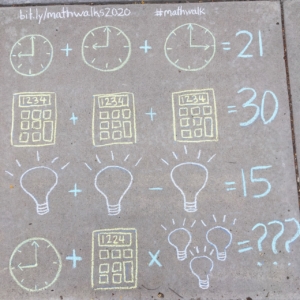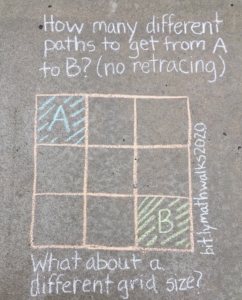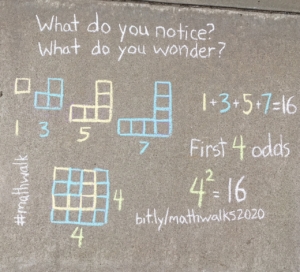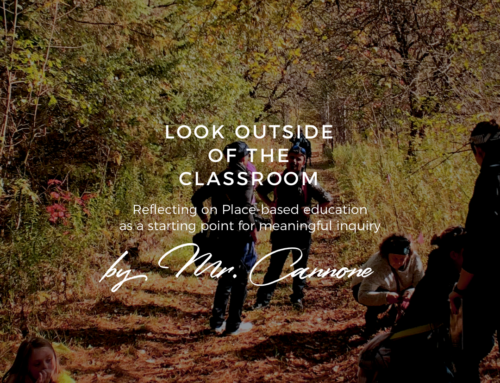Hooray! We did it! Congratulations to all students, teachers, administrators, and senior administrators for another rewarding and indeed challenging school year. Families everywhere adapted to a new way of learning and a new way of navigating life altogether. It certainly was no easy task, best described as building a plane while flying it (from a tweet I saw online)! Well, we made it to the end and that plane has landed! You all deserve a round of applause. Although we will not be taking off on a real flight anytime soon, I suggest that we use this Summer to continue the learning in creative and engaging ways. It’s likely that your child has been indoors and on the computer (for distance learning purposes) so I encourage you to consider moving outdoors with your child to engage them in any one of these math activities that require just 1 item. This week, we explore how to use sidewalk chalk (which can be purchased at the dollar store) to create meaningful invitations for mathematical learning. Get outdoors and find yourself a concrete area – perhaps the nearest sidewalk or your driveway and consider any one of these ideas for your child.
For Primary students: Gathering, sorting, and graphing data with objects in nature or objects in your home
Combine an outdoor nature walk with Math by gathering leaves and other objects. After you’ve gathered these materials, organize them in a chalk-drawn pictograph. This is a wonderful way to visually represent data on a chart using objects from their surroundings. Can’t find leaves? That’s okay. Grab some objects from inside the house or in your garage.
Have your child sort and organize these objects based on attributes that they have selected. In addition to gathering and sorting these objects, your child will be practicing counting as they determine the amount of each object. Once they have counted their items, they can organize them on their pictograph and compare values. You can also ask questions – which column has the most items? Which column has the least items? How many more items are in column 1 than there are in column 3?

For Primary students: Bean bag/Rock/Water Balloon toss
This game requires little prep and easy set up. Simply draw out a variety of large and small circles (about 15 in total) to engage your child in a tossing game. Ensure that the large circles represent a smaller value and the small circles represent a larger value (because it will be more of a challenge to land on those circles). Standing behind a throw line, your child will throw the object you’ve selected and after a select number of turns, will add up the values that their object has landed on. The winner is the person with the highest number made from their equation.
You can modify and differentiate this game by including negative numbers. As well, before each round, you can determine whether or not you will be adding the numbers you land on OR multiplying the numbers that you’ve landed on. Alternatively, you can also start at 100 and work in reverse via subtraction to see which player gets closest to zero.

For Junior students: Design a Solar system to scale
In my ten years of teaching, one Science unit that my students always have questions about is, Space! What better a way to start a conversation about Space than to design your own model Solar system…using sidewalk chalk? When designing this, you’ll want to find a nice stretch of sidewalk or driveway (at least 30 metres).
Next, visit this website, https://go.nasa.gov/2UQoteq for the specific characteristics of each planet, including each planet’s distance from the Sun. After this has been drawn out, you can ask your child to visit a planet to list additional details and to share its distance from the Sun. As an extension, you can use the information on the website to have your child construct the planet itself to scale. In designing the planet to scale, your child will also learn about radius and diameter!
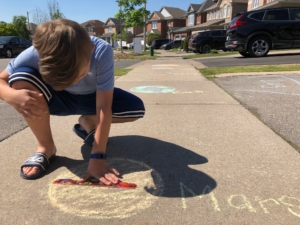

For Intermediate students: Get moving with Math
This simple game combines physical activity with Math as your child rolls the dice to determine which space to land on. Prior to this, create a winding path or rectangular, Monopoly style board game. Within each space, be sure to add relevant Math facts and prompts for your child to complete at each turn. For example, √16 + 9 = 13. In this space, include the equation and a prompt to complete 13 push ups, jumping jacks, burpees, or lunges. Consider co-creating the equations with your child, dependent on what they have learned this year or possibly, as an extra challenge, math problems that they can look forward to next year.
Consider a Math Walk #mathwalk
Educator and Rosenthal Prize Winner, Traci Jackson (@traciteacher on Twitter) has created Math Walks – bit.ly/mathwalks2020 a series of Math problems, designed outdoors using sidewalk chalk. Be sure to visit her website to view these problems and perhaps, be inspired to start a Math Walk in your neighbourhood. Imagine going for a walk with your child and stumbling upon questions that has you thinking and engaging in a problem-solving discussion. That sounds like a beautiful Summer night to me!
